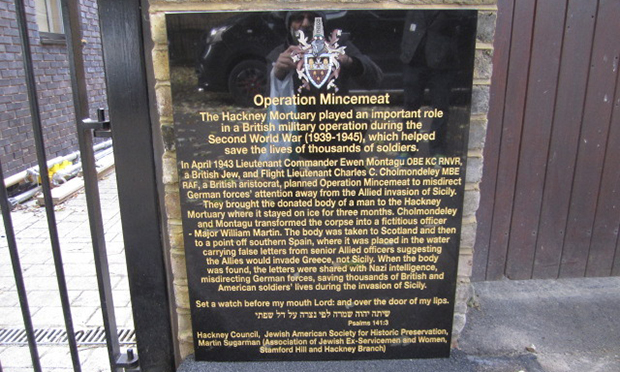Hackney mortuary that played a part in Operation Mincemeat set for capacity boost

The plaque at Hackney mortuary. Photograph: courtesy Goodman PR
It played a key role in a wartime operation which helped change the outcome of the conflict – now Hackney Council wants to increase the capacity of its historic mortuary.
It is used to store the bodies of people who have died in Hackney and for cases that have been referred to the coroner or where a death certificate cannot be issued.
The council runs the mortuary in St John’s at Hackney Church for the coroner, but has been paying £43,200 a year for extra space at St Pancras mortuary.
In spring 1943, Hackney’s mortuary was at the centre of a wartime deception which saved thousands of lives. It has since been immortalised in the 2021 film Operation Mincemeat, starring Colin Firth and Matthew Macfadyen.
The body of Glyndwr Michael, a homeless man who had been found dead in King’s Cross, was taken to the mortuary and dressed as a fictional wartime officer, acting major William Martin.
Fake documents designed to deceive the enemy were tucked into his clothing, and letters from military top brass were also placed on his body that suggested the Allies were planning to invade Europe through Greece.
In fact, the real plan was to stage an invasion at the Italian island of Sicily.
The body was later dumped off the coast of Spain and the false plans saw German military diverted to Greece.
The role of Secret Intelligence officers Commander Ewen Montagu and Flight Lt. Charles Cholmondeley has been commemorated in a plaque placed at the mortuary by the Association of Jewish Ex-Servicemen and Women.
“Why Hackney mortuary was used, no-one knows,” said the association’s archivst Martin Sugarman.
Hackney Council’s cabinet is set to agree an extra £814,000 to refurbish and modernise the building.
In the last 10 months, the mortuary was “at or near 100 per cent capacity” and the council had to buy more space elsewhere.
The extension aims to increase capacity by 64 per cent, fit a back-up electricity generator, and improve heating, ventilation and air conditioning systems.
Other costs include an estimated £20,000 for removing asbestos and £55,000 for scaffolding, parking, an area for contractors, and CCTV.
Town Hall number-crunchers believe the refurbishments “will future-proof the mortuary for the next 20-25 years”.
